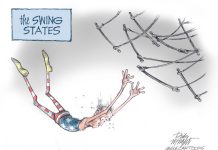By John Pickerill
We see it in the news constantly: The drug abuse epidemic. Sometimes it’s heroin. Sometimes it’s methamphetamine. Sometimes it’s prescription-drug abuse.
The results seem to be the same, though. Those addicted tend to neglect their job, their family and themselves. Emergency rooms and emergency medical responders are seeing more and more of these people overdose.
Our society’s response is to treat it like a criminal problem instead of a medical problem. And we’ve been doing it that way for 46 years. We declared the “War on Drugs” in 1971, aggressively sent the police after users and dealers to get them off the streets.
We tried to teach drug users and drug dealers a lesson by making the punishment so awful it would deter others. We made judges hand out mandatory minimum prison sentences for drug-related convictions. We allowed police to conduct civil-asset forfeiture.
Despite these aggressive policies and enforcement actions, illicit drug trade is worse than ever. In 2008, only 81 tons of the 450 tons of heroin trafficked was seized. That same year 865 tons of cocaine was trafficked worldwide, 165 tons of which was consumed in the United States (more than any other nation).
In 2009, drug use was responsible for more than 37,000 deaths in the U.S., a number that exceeded traffic accident deaths that year. Over the past decade, drug-related deaths have doubled even though all other causes of death declined. The “War on Drugs” has failed its primary objective despite receiving more than $1 trillion in funding since 1971.
What it has succeeded in doing is filling up our prisons and jails to bursting. In 1974, there were 218,466 inmates in all federal prisons, state prisons and local jails. By 2014, it exploded to 1,508,636 (a 600 percent increase). According to a study by Jonathan Rothwell, a senior economist at Gallup, more people are now admitted to prisons for drug crimes each year than for violent crimes or for property crimes. The cost on the taxpayer to house and care for these inmates is now $12.6 billion a year.
Treating drug abuse as a criminal problem instead of a medical problem is making it worse, not better. Our goal should be recovery so that the previously addicted person can overcome addiction, get his or her life back on track.
However, once we as a society label that person a felon, we make it infinitely harder for the person to do that. He or she is forced to check the box labeled “Have you ever been convicted of a felony?” when applying for a job. If the person is trying to better their life by going to college, he or she is ineligible to receive financial aid to pay for college. We are putting obstacles in the way of achieving our goal.
What are we hoping to accomplish by continuing a war-on-drugs policy? Again, the last 46 years have proven that even if we pass a plethora of get-tough-on-drugs laws, spend $1 trillion dollars and put 600 percent more people behind bars, it will not decrease the number of people getting drugs and getting addicted to drugs.
The first step to reversing all of this is focusing our resources on addiction treatment, recovery and prevention — and to try to actually solve the problem.
John Pickerill, past chairman of the Montgomery County Republican Party, wrote this for the Indiana Policy Review Foundation. A graduate of Purdue University and the Navy Nuclear Propulsion Program, Pickerill retired from the U.S. Navy with the rank of Commander.




